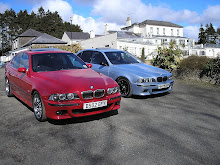SEEMS implausible.
And yet in a few drag race videos on YouTube, the old M5 beats the new M5 off the line and maintains an early lead every time – save for wet conditions – which could have more to do with the old car’s tyres. The old M5s seem neither modified nor driven by drivers of unmatched talent.
So what gives?
At first blush the numbers aren’t in the E39′s favor.E60 has 106 more horsepower than the E39; 500 hp v. 394 hp, respectively, and the new sedan has two extra cylinders; 5.0 Liter, V10 v. 5.0 Liter V8, and weighs a toy poodle or so lighter than the old car – depending upon the options.
That said, the current gen. usually comes fitted with the tricked out SMG gearbox – a sophisticated piece that can delay launch through power modulation in a more nuanced way than the E39′s six-speed stick or olde-schoole auto box. In all likelihood, the cause behind the E39′s early lead can be found in the wide difference between the two sedans’ respective torque curves.
The E60 peaks late- 383 lb-ft @ 6100 rpm. The E39 finds its apex sooner – 360 lb-ft @ 3800 rpm. The E39 M5′s engine puts out almost the same amount of power (in Newton’s terms) as its successor and its fewer horsepower manages to somehow tap the NM’s faster (initially).
BMW’s E60 M5 will find its steam somewhere near 57mph and then power on past its predecessor in an open path. But suppose the path weren’t so straight? What if the comparison was acceleration in tight, low-speed corners? Or in city- light-to-light races? That is – real world scenarios. Suddenly the new car’s hp advantage doesn’t look as hot as it once did….....
_
Subscribe to:
Post Comments (Atom)


































































































No comments:
Post a Comment